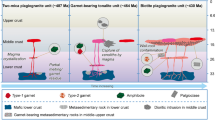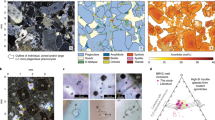Abstract
Stock-like granite plutons in the Eastern Ghats belt and their host granulites exhibit similar solid state fabric. Both mineralogically and chemically these plutons are peraluminous and granitic in composition with S-type granite affinities. The granite plutons are product of a variety of mica dehydration melting reactions, as evident from their (1) compositional plots in the (FeO + MgO) — Na2O.Al2O3 — K2O.Al2O3 (MNK) pseudoternary diagram and (2) trace element contents. Muscovite and/or biotite breakdown reaction with or without plagioclase are the characteristic melting reactions. Restitic signature is evident in the host metapelitic granulites, locally known as khondalites (Qtz-Kfs-Grt-Sil-Fe-Ti oxides-bearing gneisses). The compositional variability of the associated khondalites can be a result of (1) original compositional variation and (2) they represent different stages of restites. Trace element monitoring following restite separation model suggests that these granite plutons are largely saturated equilibrium melts. The granites are chemically discriminated as syn-collisional. The plutons could also be the product of segregation during the regional exhumation of the Eastern Ghats terrain.
Similar content being viewed by others
References
Batchelor, R. A. and Bowden, P. (1985) Petrogenetic interpretation of granitoid rock series using multicationic parameters. Chem. Geol., v.48, pp.43–55.
Bea, F. (1996a) Controls on the trace element composition of crustal melts. Trans. Roy Soc. Edin. Earth Sci., v.87, pp.33–41.
Bea, F. (1996b) Residence of REE, Y, Th and U in granites and crustal protoliths: implications for the chemistry of crustal melts. Jour. Petrol., v.37, pp.521–552.
Bhattacharya, A. and Sen, S.K. (1991) Pressure, Temperature and Fluid regime in selected granulites tracts of the Eastern Ghats of India (Abstract). In: Proc. Seminar on “composition and evolution of high-grade gneiss terrains”, IGCP Project 304, Lower crustal process, Kandy, Sri Lanka.
Bhattacharya, S. (1996) Eastern Ghats granulite terrain of India: an overview. Jour. SE Asian Earth Sci., v.14, pp.165–174.
Bhattacharya, S. (1997) Evolution of Eastern Ghats granulite belt of India in a compressional tectonic regime and juxtaposition against Iron Ore Craton of Singhbhum by oblique collision-transpression. Proc. Indian Acad. Sci., (Earth and Planet. Sci.), v.106, pp.65–75.
Bhattacharya, S., Sen, S.K. and Acharyya, A. (1994) The structural setting of the Chilka Lake granulite-migmatiteanorthosite suite with emphasis on the time relation of charnockites. Precambrian Res., v.66, pp.393–409.
Bhattacharya, S., Deomurari, M.P. and Teixeira, W. (2002) Grenvillian thermal event and remanant charnockite: Isotopic evidence from the Chilka Lake granulite-migmatite suite in the Eastern Ghats belt, India. Proc. Ind. Acad. Sci., (Earth and Planet. Sci.), v.111, pp.391–399.
Bhattacharya, S., Kar, R., Mishra, S. and Teixeira, W. (2001) Early Archaean Continental crust in the Eastern Ghats granulite belt, India: Isotopic evidence from a charnockite suite. Geol. Mag., v.138, pp.609–618.
Brown, M. (2001) Orogeny, migmatites and leucogranites: a review. Proc. Indian Acad. Sci., (Earth and Planet. Sci.), v.110, pp.313–336.
Brown, M. (1994) The generation, segregation, ascent and emplacement of granitic magma: the migmatite-to-crustallyderived granite connection in thickened orogens. Earth Sci. Rev., v.36, pp.83–130.
Brown, M. (2007) Crustal melting and melt extraction, ascent and emplacement in orogens: mechanism and consequences. Jour. Geol. Soc. London., v. 64, pp.709–730.
Brown, M. and Rushmer, T. (1997) The role of deformation in the movement of granitic melt: views from the laboratory and the field. In: M.B. Holness (Ed.), Deformation — enhanced Fluid transport in the Earth’s crust and mantle. pp.111–144.
Brown, M. and Solar, G.S. (1998) Shear-zone systems and melts: feed back relations and self-organisation in orogenic belts. Jour. Struct. Geol., v.20, pp.211–227.
Chetty, T.R.K. (2001) The Eastern Ghats Mobile Belt, India: A collage of Juxtaposed terranes (?), Gond. Res., v.4, pp.319–328.
Guernina, S. and Sawyer, E.W. (2003) Large-scale melt-depletion in granulite terranes: an example from the Archean Ashuanipi Subprovince of Qubec. Jour. Met. Geol., v.21, pp.181–201.
Halden, N.M., Bowes, D.R. and Dash, B. (1982) Structural evolution of migmatites in a granulite facies terrane: Precambrian crystalline complex of Angul, Orissa, India. Trans. Royal Soc. Edin., Earth Sci., v.73, pp.109–118.
Harley, S.L. (1989) The origin of granulites: a metamorphic perspective. Geol. Magz., v.126, pp.215–247.
Harley, S.L. (1992) Proterozoic granulite terranes, In: K.C. Condie (Ed.), Proterozoic crustal evolution, Development in Precambrian Geology 10, Elsevier, pp.301–359.
Harris, N., Ayres, M. and Messy, J. (1995) Geochemistry of granitic melts produced during the incongruent melting of muscovite: Implications for the extraction of Himalayan leucogranite magmas. Jour. Geophys. Res., v.100, pp.15767–15777.
Hollister, L. (1993) The role of melt in the uplift and exhumation of orogenic belts. Chem. Geol., v.108, pp.31–48.
Kar, R. (1995) Structural setting and post-granulite modification in an area in the northeastern sector of Eastern Ghats. Ind. Jour. Geol., v.67, pp.273–281.
Kar, R. (2007) Domainal fabric development, associated microstructures and P-T records attesting to polymetamorphism in a granulite complex of the Eastern Ghats Granulite belt, India. Jour. Earth Syst. Sci., v. 117, pp. 21–37.
Kar, R., Bhattacharya, S. and Sheraton, J.W. (2003) Hornblende dehydration melting in mafic rocks and the link between massif-type charnockite and associated granulites: Eastern Ghats granulite belt, India. Contrib. Mineral. Petrol., v.145, pp.707–729.
Kar, R. (2008) Superposed folding, transposed fabric growth in granulite facies condition: implications for possible hiatus in a granulite complex of the Eastern Ghats belt, India. Jour. Geol. Soc. India, v.71, pp.569–581.
le Breton, N. and Thompson, A.B. (1988) Fluid-absent (dehydration) melting of biotite in metapelites in the early stage of crustal anatexis. Contrib. Mineral. Petrol., v.99, pp.226–237.
le Maitre, R.W. (1989) A classification of Igneous Rocks and Glossary of Terms. Blackwell, Oxford, 193p.
Merh, S.S. (1962) Structural aspects of the charnockitic rocks of Pallavaram. Madras state. Jour. M S University Baroda, v.11, pp.123–138.
Mezger, K. and Cosca, M.A. (1999) The thermal history of the Eastern Ghats Belt as revealed by the U-Pb and 40Ar/39Ar dating of metamorphic and magmatic minerals: implications for the SWEAT correlation. Precambrian Res., v.94, pp.251–271.
Mukhopadhyay, D. and Basak, K. (2009) The Eastern Ghats Belt — A polycyclic granulite terrain. Jour. Geol. Soc. India, v.73, pp.489–518.
Passchier, C.W. and Trouw, R.A.J. (1996) Microtectonics. Springer-Verlag, Berlin, 289p.
Patino Douce, A.E. and Beard, J.S. (1995) Dehydration melting of biotite gneiss and quartz amphibolite from 3 to 15 Kbar. Jour. Petrol., v.36, pp.707–738.
Patino Douce, A.E. and Beard, J.S. (1996) Effects of P, fO2 and Mg/Fe ratios on dehydration melting of model metagreywackes. Jour. Petrol., v.37, pp.999–1024.
Patino Douce, A.E. and Johnston, A.D. (1991) Phase equilibria and melt productivity in the pelitic system: implication for the origin of peraluminous granitoids and aluminous granulites. Contrib. Mineral. Petrol., v.107, pp.202–218.
Rickers, K., Mezger, K. and Raith, M. M. (2001) Evolution of the Continental crust in the Proterozoic Eastern Ghats Belt, India and new constraints for Rodinia reconstruction: implications from Sm-Nd, Rb-Sr and Pb-Pb isotopes. Precambrian Res., v.112, pp.183–210.
Sarkar, A., Bhanumati, L. and Balasubramanyan, M.N. (1981) Petrology, geochemistry and geochronology of the Chilka Lake igneous complex, Orissa state, India. Lithos, v.14, pp.93–110.
Sawyer, E.W. (1998) Formation and evolution of granite magmas during crustal reworking: the significance of diatexites. Jour. Petrol., v.39, pp.1147–1167.
Sen, S.K. (1987) Origin of leptynites, an orthopyroxene-free granite gneiss in two granulite terranes of India. Recent Researches in Geology. In: A.K. Saha (Ed.), Geological evolution of Peninsular India, Petrological and Structural aspect, Hindusthan Publ. 13, pp.117–124.
Sen, S.K. and Bhattacharya, S. (1997) Dehydration melting of micas in the Chilka Lake Khondalites: The link between the metapelites and granitoids. Proc. Indian Acad. Sci., (Earth and Planet. Sci.), v.106, pp.277–297.
Sen, S.K., Bhattacharya, S. and Acharyya, A. (1995) A multistage pressure-temperature record in the Chilka Lake granulites: the epitome of the metamorphic evolution of Eastern Ghats, India? Jour. Metamorph. Geol., v.13, pp.287–298.
Shaw, R.K. (1996) Structural features of granulites from Rayagada, Eastern Ghats, India: some preliminary observations. Jour. Mineral. Petrol., Econ. Geol., v.91, pp.443–454.
Shaw, R.K. and Arima, M. (1997) Retrograde pressure-temperature path for spinel-bearing metapelites in Rayagada, Eastern Ghats, India. Mineral. Petrol., v.60, pp.41–59.
Spencer, K.J. and Lindsley, D.H. (1981) A solution model for coexisting iron-titanium oxides. Amer. Mineral., v.66, pp.1189–1201.
Streckeisen, A.L. (1976) To each plutonic rock its proper name. Earth Sci. Rev., v.12, pp.1–33.
Vielzeuf, D. and Holloway, J.R. (1988) Experimental determination of the fluid-absent melting relations in the pelitic system. Consequence for crustal differentiation. Contrib. Mineral. Petrol., v.98, pp.257–276.
Vigneresse, J.L., Barbey, P. and Cuney, M. (1996) Rheological Transition during partial melting and crystallisation with Application to felsic magma segregation and transfer. Jour. Petrol., v.37, pp.1579–1600.
Watson, E.B. (1988) The role of accessory minerals in granitoid geochemistry. Hutton conference on the origin of granites. Abstract in Trans. Royal Soc. Edin., pp.19–20.
Whalen, J.B., Currie, K.L. and Chappel, B.W. (1987) A-type granites: geochemical characteristics, discrimination and petrogenesis. Contrib. Mineral. Petrol., v.95, pp.407–419.
Author information
Authors and Affiliations
Corresponding author
Rights and permissions
About this article
Cite this article
Kar, R. Generation of granitic plutons during Crustal orogenesis: An example from the Eastern Ghats granulite belt. J Geol Soc India 80, 653–666 (2012). https://doi.org/10.1007/s12594-012-0191-z
Received:
Accepted:
Published:
Issue Date:
DOI: https://doi.org/10.1007/s12594-012-0191-z




